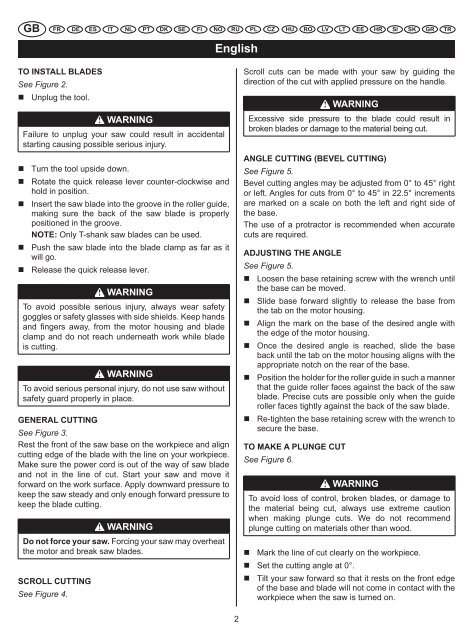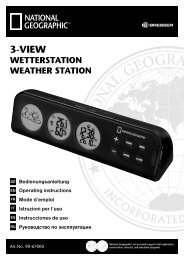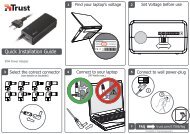gb 500w jigsaw user's manual 1 fr scie sauteuse 500w manuel d ...
gb 500w jigsaw user's manual 1 fr scie sauteuse 500w manuel d ...
gb 500w jigsaw user's manual 1 fr scie sauteuse 500w manuel d ...
Create successful ePaper yourself
Turn your PDF publications into a flip-book with our unique Google optimized e-Paper software.
GB FR DE ES IT NL PT DK SE FI NO RU PL CZ HU RO LV LT EE HR SI SK GR TR<br />
TO INSTALL BLADES<br />
See Figure 2.<br />
Unplug the tool.<br />
WARNING<br />
Failure to unplug your saw could result in accidental<br />
starting causing possible serious injury.<br />
Turn the tool upside down.<br />
Rotate the quick release lever counter-clockwise and<br />
hold in position.<br />
Insert the saw blade into the groove in the roller guide,<br />
making sure the back of the saw blade is properly<br />
positioned in the groove.<br />
NOTE: Only T-shank saw blades can be used.<br />
Push the saw blade into the blade clamp as far as it<br />
will go.<br />
Release the quick release lever.<br />
WARNING<br />
To avoid possible serious injury, always wear safety<br />
goggles or safety glasses with side shields. Keep hands<br />
and ngers away, <strong>fr</strong>om the motor housing and blade<br />
clamp and do not reach underneath work while blade<br />
is cutting.<br />
WARNING<br />
To avoid serious personal injury, do not use saw without<br />
safety guard properly in place.<br />
GENERAL CUTTING<br />
See Figure 3.<br />
Rest the <strong>fr</strong>ont of the saw base on the workpiece and align<br />
cutting edge of the blade with the line on your workpiece.<br />
Make sure the power cord is out of the way of saw blade<br />
and not in the line of cut. Start your saw and move it<br />
forward on the work surface. Apply downward pressure to<br />
keep the saw steady and only enough forward pressure to<br />
keep the blade cutting.<br />
WARNING<br />
Do not force your saw. Forcing your saw may overheat<br />
the motor and break saw blades.<br />
SCROLL CUTTING<br />
See Figure 4.<br />
English<br />
2<br />
Scroll cuts can be made with your saw by guiding the<br />
direction of the cut with applied pressure on the handle.<br />
WARNING<br />
Excessive side pressure to the blade could result in<br />
broken blades or damage to the material being cut.<br />
ANGLE CUTTING (BEVEL CUTTING)<br />
See Figure 5.<br />
Bevel cutting angles may be adjusted <strong>fr</strong>om 0° to 45° right<br />
or left. Angles for cuts <strong>fr</strong>om 0° to 45° in 22.5° increments<br />
are marked on a scale on both the left and right side of<br />
the base.<br />
The use of a protractor is recommended when accurate<br />
cuts are required.<br />
ADJUSTING THE ANGLE<br />
See Figure 5.<br />
Loosen the base retaining screw with the wrench until<br />
the base can be moved.<br />
Slide base forward slightly to release the base <strong>fr</strong>om<br />
the tab on the motor housing.<br />
Align the mark on the base of the desired angle with<br />
the edge of the motor housing.<br />
Once the desired angle is reached, slide the base<br />
back until the tab on the motor housing aligns with the<br />
appropriate notch on the rear of the base.<br />
Position the holder for the roller guide in such a manner<br />
that the guide roller faces against the back of the saw<br />
blade. Precise cuts are possible only when the guide<br />
roller faces tightly against the back of the saw blade.<br />
Re-tighten the base retaining screw with the wrench to<br />
secure the base.<br />
TO MAKE A PLUNGE CUT<br />
See Figure 6.<br />
WARNING<br />
To avoid loss of control, broken blades, or damage to<br />
the material being cut, always use extreme caution<br />
when making plunge cuts. We do not recommend<br />
plunge cutting on materials other than wood.<br />
Mark the line of cut clearly on the workpiece.<br />
Set the cutting angle at 0°.<br />
Tilt your saw forward so that it rests on the <strong>fr</strong>ont edge<br />
of the base and blade will not come in contact with the<br />
workpiece when the saw is turned on.
















